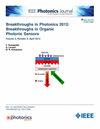用于紫外和可见光应用的200mm晶圆级Al2O3光子波导技术
IF 2.4
4区 工程技术
Q3 ENGINEERING, ELECTRICAL & ELECTRONIC
引用次数: 0
摘要
低损耗,紫外波长兼容的Al2O3光子波导已经在200毫米CMOS中导线上制造。利用椭偏仪和原子力显微镜分别对Al2O3波导层的光学特性和粗糙度进行了表征。采用棱镜耦合的方法研究了波导层中平板模式的光损耗。在200 mm的硅片上绘制了sio2包覆的Al2O3波导,并测量了266、360、450、532和638 nm波长下的传播损耗。360-638 nm的晶圆级测量显示,平均传播损耗低于0.6 dB/cm,而266 nm的晶圆级测量显示,平均传播损耗在4.3 - 14.7 dB/cm之间。为了研究工艺变化对波传播的影响,在360 nm波长处测量了大组不同臂长的Mach-Zehnder干涉仪,计算出450 nm宽、110 nm高的标准Al2O3波导的相干长度大于2.2 mm。本文章由计算机程序翻译,如有差异,请以英文原文为准。
A 200 mm Wafer-Scale Al2O3 Photonics Waveguide Technology for UV and Visible Applications
Low-loss, UV wavelength compatible Al2O3 photonic waveguides have been fabricated in a 200 mm CMOS pilot line. The Al2O3 waveguide layer optical properties and roughness were characterized by ellipsometry and AFM, respectively. Optical losses of the slab mode in the waveguide layer were studied by prism coupling. SiO2-cladded Al2O3 waveguides were patterned on 200 mm wafers and propagation losses were measured at 266, 360, 450, 532 and 638 nm wavelengths. Wafer-level measurements for 360–638 nm show an average propagation loss below 0.6 dB/cm, while die-level measurements for 266 nm yield average propagation losses between 4.3 and 14.7 dB/cm. To study the dependence of the wave propagation on processing variations, large sets of Mach-Zehnder interferometers with varying arm lengths were measured at a wavelength of 360 nm, and the coherence length of the standard 450 nm wide and 110 nm high Al2O3 waveguide was calculated to be longer than 2.2 mm.
求助全文
通过发布文献求助,成功后即可免费获取论文全文。
去求助
来源期刊

IEEE Photonics Journal
ENGINEERING, ELECTRICAL & ELECTRONIC-OPTICS
CiteScore
4.50
自引率
8.30%
发文量
489
审稿时长
1.4 months
期刊介绍:
Breakthroughs in the generation of light and in its control and utilization have given rise to the field of Photonics, a rapidly expanding area of science and technology with major technological and economic impact. Photonics integrates quantum electronics and optics to accelerate progress in the generation of novel photon sources and in their utilization in emerging applications at the micro and nano scales spanning from the far-infrared/THz to the x-ray region of the electromagnetic spectrum. IEEE Photonics Journal is an online-only journal dedicated to the rapid disclosure of top-quality peer-reviewed research at the forefront of all areas of photonics. Contributions addressing issues ranging from fundamental understanding to emerging technologies and applications are within the scope of the Journal. The Journal includes topics in: Photon sources from far infrared to X-rays, Photonics materials and engineered photonic structures, Integrated optics and optoelectronic, Ultrafast, attosecond, high field and short wavelength photonics, Biophotonics, including DNA photonics, Nanophotonics, Magnetophotonics, Fundamentals of light propagation and interaction; nonlinear effects, Optical data storage, Fiber optics and optical communications devices, systems, and technologies, Micro Opto Electro Mechanical Systems (MOEMS), Microwave photonics, Optical Sensors.
 求助内容:
求助内容: 应助结果提醒方式:
应助结果提醒方式:


